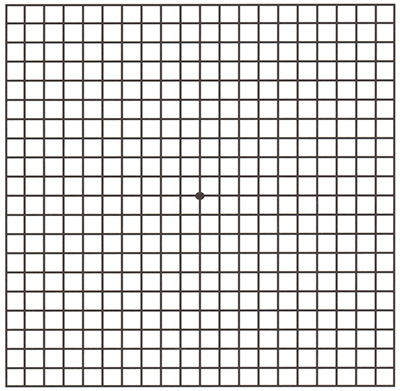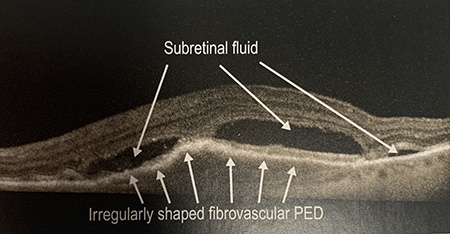Age-Related Macular Degeneration (AMD)
Age related macular degeneration (AMD) is one of the most common causes of poor vision after age 60. AMD is a deterioration or breakdown of the macula. The macula is a small area at the center of the retina in the back of the eye that allows us to see fine details clearly and perform activities such as reading and driving.
The visual symptoms of AMD involve loss of central vision. While peripheral (side) vision is unaffected, one loses the sharp, straight-ahead vision necessary for driving, reading, recognizing faces, and observing details.
The Amsler Grid is a tool that can help patients notice early changes in their vision related to progression of macular degeneration.
Although the specific cause is unknown, AMD seems to be part of aging. While age is the most significant risk factor for developing AMD, heredity, blue eyes, high blood pressure, cardiovascular disease, and smoking have also been identified as risk factors.
AMD accounts for 90 percent of new legal blindness in the US. In individuals with moderate to severe AMD, a specific type of vitamin supplement may be helpful.
A diet rich in coloured vegetables, such as carrots and spinach, as well as protecting the eyes from UV light, can help to delay progression of disease.
Nine out of 10 people who have AMD have the dry form (called atrophic), which results in thinning of the macula. Dry AMD takes many years to develop. Currently there is no treatment for this form of AMD.
The wet form of AMD (called exudative) is less common (occurring in one out of 10 people with AMD), but is more serious. In the wet form of AMD, abnormal blood vessels may grow in a layer beneath the retina, leaking fluid and blood and creating distortion or a large blind spot in the center of your vision.
If the blood vessels are not growing directly beneath the macula, laser surgery is an effective treatment for wet AMD. The procedure usually does not improve vision but prevents further loss of vision.
For those wet AMD patients whose blood vessels are growing directly under the center of the macula, a procedure called photodynamic therapy (PDT) may be used to treat some patients with fewer visual side effects than other treatments.
More recently, new medications that target the growth of blood vessels have been developed. When injected into the eye, they too can help reverse the ill effects of macular degeneration in certain patients.
Promising AMD research is being done on many fronts. In the meantime, high-intensity reading lamps, magnifiers and other low-vision aids help people with AMD make the most of their remaining vision.

External Eye Anatomy

Internal Eye Anatomy

Amsler grid

OCT image of the retina in wet macular degeneration. This patient would benefit from anti-VEGF injections.
